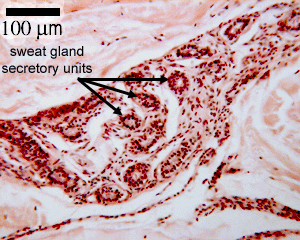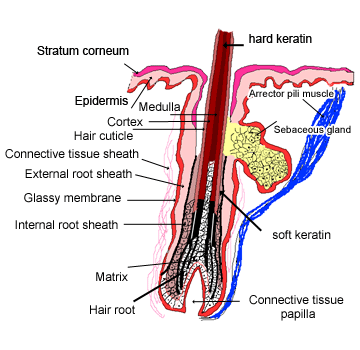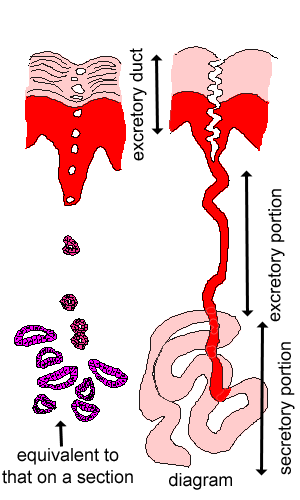Three types of glands
Eccrine/merocrine Sweat Glands

This shows a photo of the secretory portion of the sweat glands at higher magnification. The secretory parts are lined by simple cuboidal epithelium. The ducts are lined by stratified (2 layers) cuboidal epithelium. Long thin myoepithelial cells are arranged helically around the periphery between the secretory cells and their basement membrane. When they contract, they increase the amount of sweat produced (i.e. in fear, anxiety or stress - you will get sweaty palms!).
The sweat glands are simple tubular exocrine glands that are found in the superficial hypodermis bordering
on the dermis. They discharge their contents onto the surface
of the skin via coiled secretory ducts (see the diagram opposite).
The ducts open out onto epidermal ridges at a sweat pore. They
can be further classified as merocrine
(eccrine) glands. They secrete a watery fluid which is hypotonic
to plasma its evaporation is important for thermoregulation. Sweat
contains water, sodium, potassium, chloride, urea ammonia and
lactic acid.
Sebaceous Glands

This diagram shows the main features of a hair, and its associated sweat gland.
Sebaceous glands are branched acinar (spherical) glands which
make an oily substance called sebum. The rounded cells are filled
with lipid filled vacuoles, and towards the end of the duct, the
cells degenerate to release their contents into the duct - HOLOCRINE
secretion. This oil coats hair and the surface of thin skin to
help keep it soft, supple and waterproof.
At puberty, the size of the sebaceous glands, and their secretory
activity increase, in response to increasing levels of androgens.
If the gland become blocked, the sebum can be forced out into
the dermis, where it elicits an inflammatory response. This can
cause acne.
Take a look at this sebaceous gland. Can you identify the sebaceous
gland and duct, the hair, arrector pili muscle, and the IRS and
ERS (internal and external root sheaths) of the hair?
Notice the changes in the ERS and IRS near the duct, the cells
of the sebaceous gland disintegrate near the duct, and the duct
opens out upwards onto the hair.
Apocrine Sweat Glands.
These are only found in the axillae, breast, and pubic and perineal
regions. They are similar to apocrine sweat glands, but open out
onto the upper regions of hair follicles, like sebacous glands.
They only secrete after puberty. They produce a cloudy secretion,
which starts to smell if bacteria react with it. (So, you need
to wash, frequently!)


